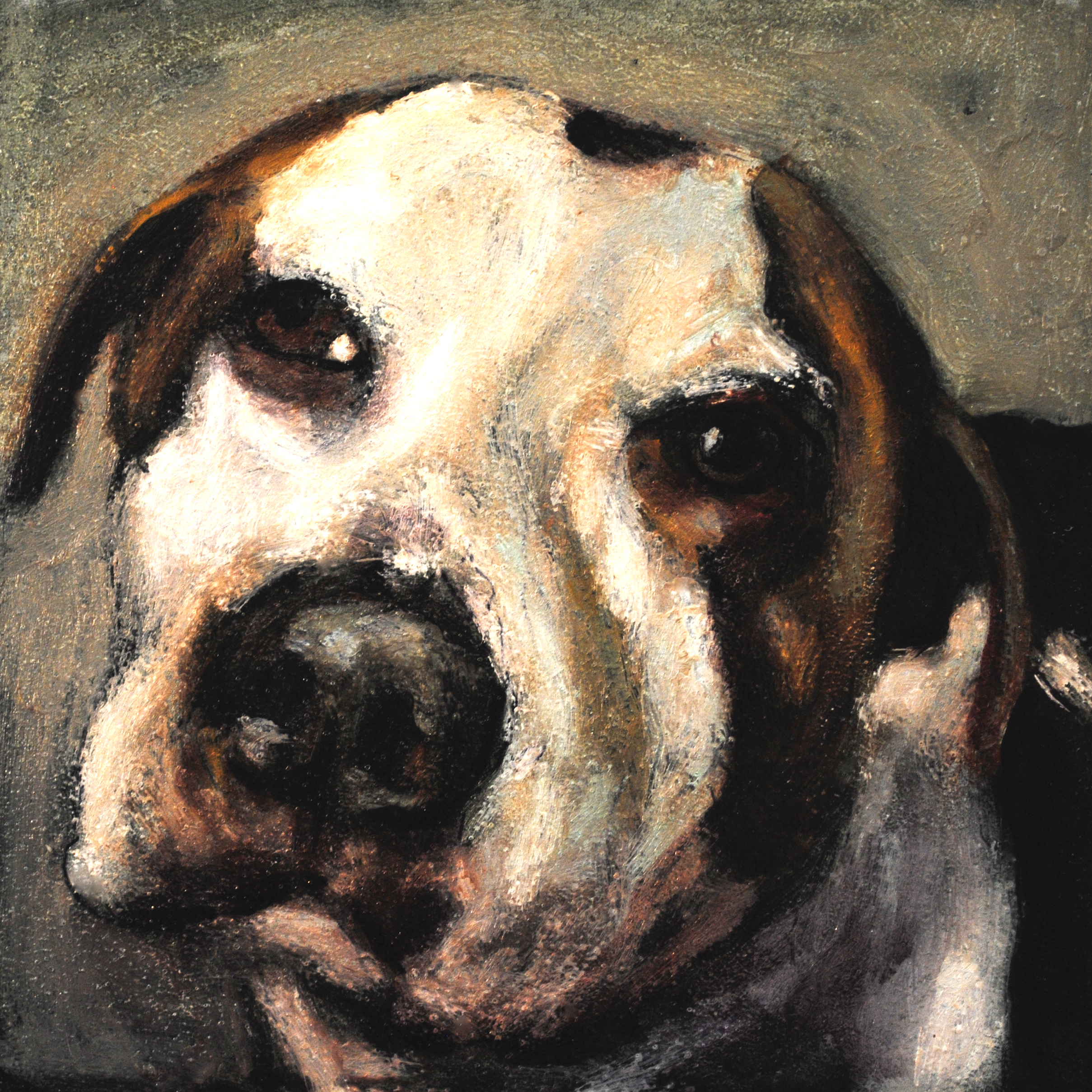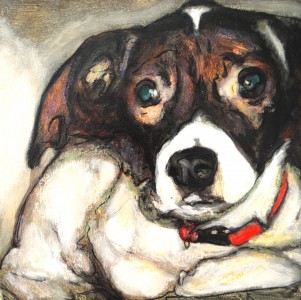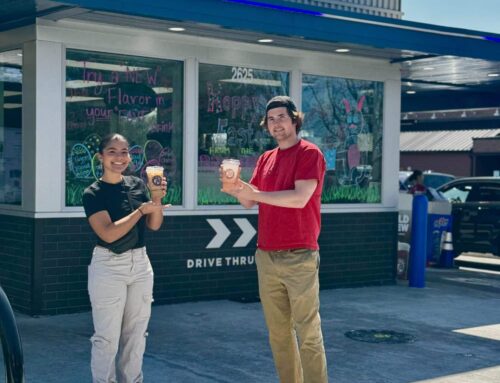
Barone and Dervan did adopt a dog, Gigi, a hound and beagle mix. They are pictured here in Barone’s studio along with some of his completed paintings.
By Simon Isham–
Painting 5,500 portraits in two years. That is the undertaking that local artist Mark Barone has committed to. These portraits are unusual, though, in that they are not depictions of or commissioned by people; rather, they are Barone’s own memorials to dogs that have been killed in animal shelters because they could not find homes.
Barone and his wife Marina Dervan are the co-founders of An Act of Dog, a charity that speaks for those who cannot speak for themselves; the goal of the project is to raise 20 million dollars for animal shelters that do not euthanize. Co-founders Marina Dervan and Mark Barone are currently searching for a city to be the permanent home for the An Act of Dog museum, where all 5,500 portraits will be displayed. Louisville is in the running to be that city.
“I always wanted to make sure that this was a purpose-driven project and not a purse-driven project,” said Dervan. As a former nutritionist and self-styled “Honesty Coach,” Dervan’s media-relations duties as cofounder of An Act of Dog is a 180 degree reversal from her previous job experience.
An Act of Dog has proven to be a 180 for Barone, too, who previously painted about the human condition instead of the canine one. Barone received his Bachelors of Science in Design from the University of Minnesota and his Masters of Fine Arts from Southern Illinois University after which he began to paint his own work. It was at about this time that the first dog found its way into one of Barone’s paintings, but dogs were never the focus. Instead, he viewed them as symbols of loyalty in the background.
Dogs migrated to the foreground in late 2010. After the death of a 21-year-old canine companion and a move from St. Louis, Mo. to Santa Fe, N.M., Dervan and Barone began visiting dog parks in an attempt to heal. Even though Barone did not think that he was not ready for another dog, Dervan did, and began to search shelter sites for adoptables. This was how the couple first learned about what goes on in kill shelters.
“I’d come home after work, tired, and Marina would be sitting there at the kitchen table, crying about the videos she saw that day. So finally we started talking about it and what we could do. The next day I told her to find me the number of how many dogs are killed in the United States each day,” said Barone.
The number Dervan came back with was 5,500 — which she says is lowballing the figure. According to PETA, the Humane Society of the United States, the ASPCA and countless other animal advocacy groups, between three and four million animals are euthanized in the United States each year, of which Dervan said two million are dogs. This roughly equates to 5,500 dogs per day. Cats have it even worse — Dervan estimates that the death rate of cats in shelters is nearly double that of dogs.
Through their An Act of Dog project, Dervan and Barone hope to bring attention to all shelter animals, not just dogs. Barone chose to paint dogs because he believes they are symbolic of all domestic animals, and because including cats would have taken a chunk of time that Barone asserts these animals just don’t have. It was this feeling of urgency that caused Dervan and Barone to cash in three IRAs, their entire retirement savings, to launch An Act of Dog out of their kitchen in Santa Fe.
It was clear that this would not be enough space, however. So Dervan reached out to 32 cities in the hopes of having their living quarters and studio space subsidized. Louisville stepped forward, offering the couple a discounted house and a large studio space at Mellwood Art and Entertainment Center on Mellwood Ave. “We could have waited on another city, but we were really chomping at the bit to get going,” said Barone.
All of the An Act of Dog portraits are paintings of real dogs that have been euthanized. To maintain accuracy towards the individuality of each dog, Barone paints from photographs of the dogs taken by shelter staff. The problem with these photographs is that they are not as numerous as euthanized dogs — kill shelters simply do not give a full photographic report on every single dog that is killed on location.
In lieu of this, Dervan has turned to other methods of gathering photos: one of the main resources she uses is the memorial gallery on dogsindanger.com, a non-profit final recourse to find homes for dogs on death row.
Dervan said she tries to include all different types of dogs, as she feels that people have preconceived ideas about the kinds of dogs that are typically euthanized. “And you get to know the shelters as well,” she said “You don’t know where they are, but you get to know the shelters because you see these same backgrounds. You know there are a lot coming out of some shelters in particular.”
Another resource Dervan uses is people who send in photos of dogs whom they have bonded with in shelters but have been unable to adopt and would like to have a painting done in memorial to their lost friend. Many of the dogs in the photographs that Dervan and Barone receive have numbers rather than names, so every dog whose portrait is painted is honored with a name.

Lollie was a labrador-pit bull mix and was euthanized on Mar. 3, 2011.
The painting process starts with a wall-to-wall stack of four-foot by eight-foot wooden planks. Barone saws the planks down to size himself. He chose to paint on one-foot by one-foot square boards so because he feels that they are easier to paint than canvas, but also because hanging them presents less of a challenge. With canvas, an artist must stretch it over a frame, attach a wire with which to hang it and mount it to the wall, making sure that it is level with all the others. With boards, he can simply screw a J-channel — essentially a short trough — to the wall and slide each painting in. This is how Barone expects to place them in the museum.
After the boards have been cut, Barone applies coats of gesso to each one. Gesso is a preparatory white paint that dates from the ancient world. It is applied to woods that will be painted on to smooth out the surface and give the paint something to stick to. When the boards have been coated in gesso, Barone takes them into another room, where he sketches out a dog, using the photographs Dervan gathers from the Internet as a guide. He takes these sketches to the third room in his studio, where he paints an initial picture in sepia tones, later to be followed by the final colors in oils and paint sticks.
And so Hennessy, the very first dog painted from the series, was depicted. According to Barone, Hennessy’s portrait took one-and-a-half hours to complete. Now that he has worked out a definite style and rhythm for the work, the portraits take about one third of the time — 30 to 45 minutes per painting. Barone works twelve hours per day on the project, but must make room in his schedule for sawing, applying gesso, sketching, taking interviews and being human. Thus, he finishes around 12 to 15 portraits per day. To date, he has completed over 3,000 paintings for the series.
Barone takes intermittent breaks from painting portraits for the series in favor of painting other work, but this other work is never too far removed from what the An Act of Dog project is about, and dogs are always included in them. The “break” paintings are usually larger in size than those of the series, which Barone says allows him to explore not just the faces of the dogs, but also the scenery and how the dog plays into it. Some images are whimsical, like a dog playing with his master in a dog park; some are grim, like a lone dog in a gas chamber at a kill shelter.
Some of these themes will be touched on in the museum by five paintings which will be larger than all the rest. These paintings will examine famous euthanizations and issues that are central to understanding shelter culture, such as Black Dog Syndrome. Dervan explained that animals with black fur are less likely to be adopted than animals with other colors of fur, and it is for this reason that they are euthanized far more frequently than animals with other colors of fur–sometimes within the same day they are brought in.
“I don’t know what it is about that color,” said Dervan. “Some people say that when you take a picture of a black dog versus a multicolored dog, it just doesn’t look the same … There’s also the idea that black animals, especially cats, are bad luck.”
“But if you’re a black pit bull, you’re out of luck,” added Barone.

Rocky was pit bull-mix who was euthanized on Mar. 6, 2011.
Libby Sherill, a documentary filmmaker, is all too familiar with discrimination in dog breeds. Her film “Beyond the Myth” is about public profiling and general fear of pit bulls. Dervan and Barone are in frequent contact with Sherill, and had even planned to make a live-action documentary about their work in conjunction with her. This project has been tabled in favor of creating a family-friendly animated documentary for the exclusive use of the museum once it is up and running. Dervan and Barone would also like for their museum to contain studio space for an artist-in-residence to work, adding to the collection of the museum and highlighting other important shelter-specific issues.
“Part of the project is to debunk existing myths and help people look at the facts, because that’s what we had to do. We want to let them walk away with what they can do to be a part of the solution.” added Dervan.
Dervan hopes that college students will also be a part of the solution by using social media to make An Act of Dog’s message heard. But it isn’t only college students who can do this; Mollie Whitehead, an accountant from Birmingham, Al., is An Act of Dog’s biggest fan. She found the project on Facebook, and has been supporting it by sharing Dervan’s updates with her circle of friends, who in turn support the project. “The more exposure they get, the better it is for the project. And if funds were available from other sources, I would definitely be hounding people to put money into it,” said Whitehead.
Dervan and Barone plan to honor Whitehead at the end of the creation period by giving her the painting that is the background for their logo, and also by allowing her to be the first person to donate towards the 20 million dollar capital campaign.
Donors can become either Sponsors or Benefactors. Sponsors are donors who give a one-time donation of $25 or more. The money goes towards creating the exhibit, and all sponsors will have their name on one of the portraits. Benefactors are annual donors who give more than $220 at one of the foundation’s Seven Levels of Kindness, and receive various membership benefits at the museum when it opens.
As a community of people who care about animals, Dervan and Barone are blown away by Louisville. They have not been quite so enchanted with the city government’s efforts to achieve a “no-kill” designation, which requires a save rate of 90 percent. “You still have a long way to go,” said Dervan.
Dervan and Barone have a meeting with the Economic Development Department of the Metro Council on Dec. 4, where they will discuss how Louisville can better work towards a “no-kill” goal. This is one of the many factors in whether An Act of Dog chooses to locate its museum here. One of the concepts they plan to bring to the EDD’s attention is No-Kill Advocacy Center Director Nathan J. Winograd’s 11-step “No-Kill Equation,” which provides cities with a pathway to attain a 90 percent save rate.
Other aspects that are important to Dervan and Barone in choosing a city in which to locate their museum are freedom from ulterior motives on the part of city officials and not being forced out of space that they had been promised due to a rent hike.
Dervan and Barone are so adamant about what they want to see in a host city because they believe that their museum is on a different level than traditional animal-advocacy charities. Dervan contrasts the Kentucky Humane Society with An Act of Dog: “Kentucky Humane Society is a wonderful shelter, as all shelters that have a positive intent are, but it’s not no-kill. They don’t kill to make space anymore, but that’s kind of a loophole to kill for other reasons. They should step up and be no-kill. That’s our position on that, honestly. What we’re doing is giving our funds to shelters that are committed, 100 percent, to life. You make the decision.”
[email protected]
Photo courtesy Mariana Dervan






